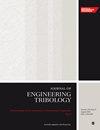Fretting wear characteristics evolution mechanism of 60Si2MnA steel for high-speed railway fastener clips
IF 1.6
3区 工程技术
Q3 ENGINEERING, MECHANICAL
Proceedings of the Institution of Mechanical Engineers, Part J: Journal of Engineering Tribology
Pub Date : 2024-07-01
DOI:10.1177/13506501241233347
引用次数: 0
Abstract
The fastener clips of the high-speed railway may fracture due to accumulated fretting damage, posing a hazard to train operation safety. To investigate the evolution mechanism of fretting wear characteristics of high-speed railway fastener clips, this paper conducted fretting wear tests on 60Si2MnA steel used for clips and analyzed the fretting wear characteristics under different number of fretting cycles (N). The results indicate that as N increases, the friction coefficient rises initially, then falls, slightly rises again, and eventually stabilizes. Furthermore, the surface wear volume and depth of 60Si2MnA steel material increase continuously, and its fretting wear mechanism undergoes a transformation. Specifically, at 20,000 cycles, surface plastic deformation primarily causes material damage. While at 40,000 cycles, an oxide plastic deformation layer appears on the material surface, where adhesive wear and oxidation wear become the primary wear mechanisms. When N increases to 80,000, plastic strain accumulates continually on the material surface, causing the oxide plastic deformation layer in the outer contact area to break and detach gradually. Adhesive wear transforms into abrasive wear, cracks occur inside the material, and fatigue wear becomes a significant wear mechanism. This study fills the research gap in the fretting wear evolution mechanism of 60Si2MnA steel.高速铁路扣件夹用 60Si2MnA 钢的摩擦磨损特性演变机理
高速铁路的扣件卡箍可能会因累积的烧损而断裂,对列车运行安全造成危害。为了探究高速铁路扣件卡箍摩擦磨损特性的演变机理,本文对用于卡箍的 60Si2MnA 钢进行了摩擦磨损试验,分析了不同摩擦循环次数(N)下的摩擦磨损特性。结果表明,随着 N 的增加,摩擦系数从最初的上升,到下降,再到略微上升,最终趋于稳定。此外,60Si2MnA 钢材料的表面磨损量和磨损深度不断增加,其摩擦磨损机理也发生了转变。具体来说,在 20000 次循环时,表面塑性变形是造成材料损坏的主要原因。当循环次数达到 40,000 次时,材料表面出现氧化塑性变形层,粘着磨损和氧化磨损成为主要的磨损机制。当 N 值增加到 80,000 时,塑性应变在材料表面不断累积,导致外接触区域的氧化塑性变形层逐渐破裂和脱落。粘着磨损转变为磨料磨损,材料内部出现裂纹,疲劳磨损成为一种重要的磨损机制。本研究填补了 60Si2MnA 钢摩擦磨损演变机理方面的研究空白。
本文章由计算机程序翻译,如有差异,请以英文原文为准。
求助全文
约1分钟内获得全文
求助全文
来源期刊

CiteScore
4.20
自引率
5.00%
发文量
110
审稿时长
6.1 months
期刊介绍:
The Journal of Engineering Tribology publishes high-quality, peer-reviewed papers from academia and industry worldwide on the engineering science associated with tribology and its applications.
"I am proud to say that I have been part of the tribology research community for almost 20 years. That community has always seemed to me to be highly active, progressive, and closely knit. The conferences are well attended and are characterised by a warmth and friendliness that transcends national boundaries. I see Part J as being an important part of that community, giving us an outlet to publish and promote our scholarly activities. I very much look forward to my term of office as editor of your Journal. I hope you will continue to submit papers, help out with reviewing, and most importantly to read and talk about the work you will find there." Professor Rob Dwyer-Joyce, Sheffield University, UK
This journal is a member of the Committee on Publication Ethics (COPE).
文献相关原料
| 公司名称 | 产品信息 | 采购帮参考价格 |
|---|
 求助内容:
求助内容: 应助结果提醒方式:
应助结果提醒方式:


